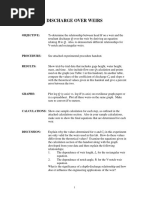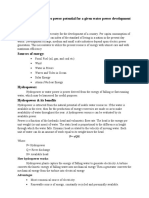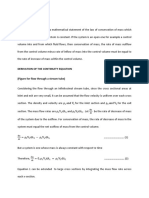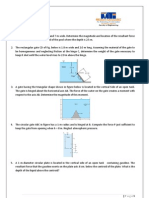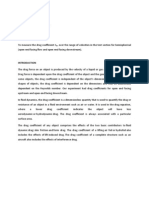Calibration of Contracted Rectangular Weir
Uploaded by
Dianne Ilao LondobCalibration of Contracted Rectangular Weir
Uploaded by
Dianne Ilao LondobCALIBRATION OF CONTRACTED RECTANGULAR WEIR
Dianne Londob 08-05378
ABSTRACT In this activity, the contracted rectangular weir is calibrated.Laboratory flume A is utilized, contracted rectangular weir and suppressed rectangular weir fixed at the bottom are used for determination of actual and theoretical discharge respectively. Dimension and depth measurements are done via meter stick or point gage. Computation of discharge is only dependent to the head above the crest and width of the weir.Theoretical and actual discharge are utilized to compute for the value of the coefficient of discharge.
INTRODUCTION There are several methods used to measure flow in small open channels such as irrigation ditches, drainage canals, aqueducts, or sewage treatment plant channels. Many of the flow measurement methods typically utilize an underflow gate, flume structure or weir. In this experiment, weir is used to measure the fluid flow. A weir is a partial obstruction placed across the flow in the channel causing the liquid to back up, upstream of the obstruction and then flow over it. When the liquid flows over the weir the depth of the flow above the crest level of the weir bears a relationship with the discharge over it.Thus the discharge through an open channel can be obtained by the measurement of a single parameter i. e. The head of liquid above the crest of the weir. The shape of the flow area in the plane of the weir plate is used to determine the type of weir being used: rectangular, triangular, and trapezoidal. Weirs may be sharp-edged (sharpcrested), rounded, or broad-crested. Moreover, each weir type will have unique features and produce effects that make it more or less suitable for specific applications The activity will investigate and experimentally determine the discharge coefficients for contracted rectangular weir. Fully contracted rectangular weir is the most frequent standard weir used in irrigation. A contracted rectangular weir is one for which the weir extends across only part of the channel, so that the width of the weir, L, is different from as the width of the channel. The diagram below shows some of the key parameters used in contracted rectangular weir flow rate calculations. Specifically, the height of the weir crest, P, the head over the weir, H, the weir length, L, and the channel width, B, are shown on the diagram of a contracted rectangular weir in a rectangular channel.
Figure 1 Key Parameters used in Contracted Rectangular Weir The experiment requires to set a series of discharges . Using the head measured (elevation of the streamline ) and the corresponding theoretical and actual discharge measured on the supprressed rectangular weir and on the contracted rectangular weir respectively , a headdischarge relationship is determined.The average coefficient of discharge for the given weir is determined by comparing the theoretical and measured results.
THEORETICAL BACKGROUND Applying Bernoullis Equation along a streamline between a point upstream of the weir (where the velocity head is neglected) and a point in the plane of the weir, the velocity ,V, at the weir is = 2 equation (1)
Where C is the velocity coefficient, g is the gravitational acceleration and H is the elevation of the streamlinebelow the free surface.
From the continuity equation, Q= AvV, and expressing the area of the vena contrata in terms of the weir opening, Av=CcA where Cc is the contraction coefficient. = Letting Cd = CcC = 2 equation (3) 2 equation (2)
For contracted rectangular weir at the upper portion, efficient L = L-0.2H and A= H(L-0.2H). Therefore = 0.2 2 equation (4)
Simplifying the above equation, Actual discharge of the fluid is obtained = 2 0.2 equation (5)
For the suppressed rectangular weir at the bottom, A= HL. Therefore theoretical disharge can be computed as: = 2 = 2 equation (6)
Experimental Coefficicient of discharge is computed as: = equation (7)
It is then compared to the theoretical coefficient of discharge of contracted rectangular weir is given by Rehbock's Formula. = 0.611 + 0.075 EXPERIMENTAL SET-UP The experiment is conducted using Laboratory Flume A, an open channel flume facility located in National Hydraulics Research Center. The weir subjected to flow measurement in this experiment is rectangular contracted weir. The geometry of this weir is sketched in the Figure 2. The weir shape is cut from brass/tin sheets and can be considered as being sharpedged. equation (8)
Figure 2 Geometry of Rectangular Contracted Weir The physical model made use of laboratory flume A (sluice gate operation) with a contracted rectangular weir for the upper part and suppressed rectangular part on the lower part in order to measure the actual and the theoretical discharges respectively.
Figure 3 Laboratory Flume A ( Sluice Gate Operation) The contracted rectangular weir is set at the middle portion of the flume sufficiently wide and deep to give an even, smooth flow. The centerline of the weir notch is placed parallele to the direction of the flow. The face of the weir is placed vertical, not leaning upstream nor downstream.the crest of the weir is placed level so the water passing over it will be of the same depth at all points along the crest. The crest is placed high enough so water will fall freely below the weir leaving an air space under the over falling sheet of water.
Figure 4 Sketch Definition for Weir (Side View) Preliminary measurements of the removable contracted rectangular weir at the upper portion and the fixed suppressed rectangular weir dimensions are done first before generating the flow. The sluice gate is then opened to permit water inflow. The group waited for the flow to be steady. Y1(Water Level) is then measured at a distance from the weir (where the velocity head is neglected )as the height of the water level with respect to the floor of the flume. H1 (height of the streamline)is then calculated by subtracting P1(height of the crest)from Y1, H1 and the width of the weir are then used to calculate the actual discharge using Equation (5). Same procedure is followed in computing for the theoretical disharge of the same fluid flow using the suppressed rectangular weir. Y2 is measured, compute for H2 ang using H2 and L2 using Equation (6),. Sluice gate opening is then made to vary every trial to vary Y1 and Y2. Theoretical and actual discharges are then compared. Head- discharge relationship derived from contracted rectangular weir flow measurement are derived and later compared to the discharge measured by the suppressed rectangular weir.Theoretical and actual discharge are then graphed taking theoretical discharge on the x-axis.Using linear regression, the slope was calculated and this is taken to be the coefficient of discharge
TEST RESULTS Table 1 contains the preliminary measurements of the two weirs, contracted rectangular and suppressed rectangular weir. This values will be essential in calculating the head, theoretical and actual discharge of the fluid flow. Table 1 Weir Dimensions Weir type Contracted Rectangular Suppressed Rectangular
Width (m) 0.12 0.45
Height of the Crest (m) 0.235 0.3048
Table 2 contains the calculation for actual discharge. Y1(ft) or the water level is measured using a vernier submerged in water, it is then converted to Si Unit. Y1 (m) is then subtracted by the crest level which resulted to Hu1 (head above the crest). Values of H1 and W1 (width of the contracted rectangular weir) are then substituted to Equation (5) to compute for Qact(actual discharge) Table 2 Computation for Actual Discharge Trial Y1 (ft) Y1 (m) 1 2 3 4 5 6 7 8 9 10 0.9620 0.9040 1.0070 0.9500 1.1670 1.1940 0.8600 1.1500 1.0210 0.8800 0.29321760 0.27553920 0.30693360 0.28956000 0.35570160 0.36393120 0.26212800 0.35052000 0.31120080 0.26822400
H1 (m) 0.05821680 0.04053840 0.07193280 0.05455920 0.12070080 0.12893040 0.02712720 0.11551920 0.07620000 0.03322320
Q act (m3/s) 0.00449455 0.00269686 0.00601683 0.00410523 0.01187026 0.01287972 0.00151166 0.0112343 0.00650708 0.00202704
Table 3 contains the calculation for theoretical discharge. Y2(m)or the water level is measured using meter stick sonce the group found out that the vernier is erroreous. Y2 (m) is then subtracted by the crest level(0.3048m or 1 ft) which resulted to Hu2 (head above the crest). Values of Hu2 and W2 (width of the contracted rectangular weir) are then substituted to Equation (6) to compute for Qact(actual discharge) Table 3 Computation for Theoretical Discharge Trial 1 Y2(m) H2 (m) 1 2 3 4 5 0.336 0.328 0.341 0.334 0.364 0.0312 0.0232 0.0362 0.0292 0.0592
Q theo 0.00732323 0.00469573 0.00915237 0.00663048 0.0191405
6 7 8 9 10
0.366 0.32 0.361 0.344 0.324
0.0612 0.0152 0.0562 0.0392 0.0192
0.02011861 0.00249021 0.01770416 0.01031335 0.00353527
Figure 5 shows the relationship of the head to its corresponding theoretical and actual discharge.Theoretical discharge is higher than the actual discharge. This implies that the coefficient of discharge for this experiment is less than unity, as stated in fluid mechanics standard textbook.
Head vs Discharge
0.025 y = 0.374x2 + 0.116x - 0.000 R = 0.998
D i s h a r g e
0.02
0.015 Actual Discharge 0.01 y = 0.199x2 + 0.081x - 0.000 R = 0.999 Theoretical Discharge
0.005
0 0.00000000 0.05000000 Head 0.10000000 0.15000000
Figure 5 Head vs Discharge
Figure 6 illustrate the relationship between the theoretical and actual discharge. The slope of the best fit line is consider to be the coefficient of discharge which is 0.641 Table 4 compuation of Theoretical Coefficient of Discharge using Rechbock Equation Trial Head Theoretical Coefficient of Discharge 1 0.05821680 0.640502 2 3 4 5 0.04053840 0.07193280 0.05455920 0.12070080 0.623938 0.633957 0.628413 0.649522
6 7 8 9 10
0.12893040 0.02712720 0.11551920 0.07620000 0.03322320 Average
0.652148 0.619658 0.647868 0.635319 0.621603 0.635293
The coefficient of discharge for this experiment using the contracted rectangular weir is 0.641, very closed to the theoretical value of coefficient of discharge of contracted rectangular weir which is 0.635293 shown in Table 4 .
0.014 D i s c h a r g e 0.012 0.01 0.008 0.006 0.004 0.002 0 0 0.005 0.01 0.015 Theoretical Discharge 0.02 0.025 Theoretical discharge vs Actual Discharge y = 0.641x - 0.000
THEORETICAL DISCHARGE VS ACTUAL DISCHARGE
A c t u a l
Figure 6 Theoretical vs Actual Discharge Additional observation regarding the activity is that weir flow computation is only dependent to weir geometry and head of water above the crest. CONCLUSIONS AND RECOMMENDATIONS The results have shown that the experimental coefficient of discharge of the contracted rectangular weir is 0.641. Head above the crest is directly proportional to the fluid flow.The theoretical and actual results agree for most of the relationship established. Possible sources of error for the experiment include measurements of Y2. This section of the fluid flow has very rapid flow that the actual measurements are only as good as estimates for this depth. Also, the meter stick used for the activity has low accuracy compared to vernier. BIBLIOGRAPHY Dizon, Cornelio, CE 16 Laboratory Notes dated 8/17/2011 Streeter, V.L. FLUID MECHANICS, McGraw-Hill, 1998
You might also like
- Weir Flow Using The Rehbock Equation 120704No ratings yetWeir Flow Using The Rehbock Equation 1207041 page
- De - Referral Hydraulics Lab Sheet Cousework - 2020-21yrNo ratings yetDe - Referral Hydraulics Lab Sheet Cousework - 2020-21yr14 pages
- Basics Configuration of PBX - Nortel Meridain 81c100% (4)Basics Configuration of PBX - Nortel Meridain 81c26 pages
- BIAS AMP Models and Modeling References PDFNo ratings yetBIAS AMP Models and Modeling References PDF4 pages
- Lab-2: Flow Over A Weir Objectives: Water Resources Engineering Jagadish Torlapati, PHD Spring 2017No ratings yetLab-2: Flow Over A Weir Objectives: Water Resources Engineering Jagadish Torlapati, PHD Spring 20174 pages
- Moisture-Density Relationship (Standard Proctor Test) : I. ObjectivesNo ratings yetMoisture-Density Relationship (Standard Proctor Test) : I. Objectives6 pages
- Design Analysis of Flow Over Rectangular Channel100% (1)Design Analysis of Flow Over Rectangular Channel19 pages
- Design 3, Estimation of The Hydro Power Potential For A Given Water Power Development SchemeNo ratings yetDesign 3, Estimation of The Hydro Power Potential For A Given Water Power Development Scheme10 pages
- Manual Laboratory Experiment No. 4 BangguiyacNo ratings yetManual Laboratory Experiment No. 4 Bangguiyac11 pages
- Lab Manual 2 Rectangular and Triangular NotchesNo ratings yetLab Manual 2 Rectangular and Triangular Notches8 pages
- Experiment 2, Flow Over A Broad Crested WeirNo ratings yetExperiment 2, Flow Over A Broad Crested Weir4 pages
- Spillways: 5.1. 5.2. General Formula 5.3. Sharp-Crested Weir 5.4. The Overflow Spillway 5.5. Broad-Crested WeirNo ratings yetSpillways: 5.1. 5.2. General Formula 5.3. Sharp-Crested Weir 5.4. The Overflow Spillway 5.5. Broad-Crested Weir17 pages
- Standard Method For Gradually Varied FlowNo ratings yetStandard Method For Gradually Varied Flow5 pages
- CE142P-2 / E01 Engr. Edward Monjardin 01-09-21 01-12-21: Jingona, Fatimah Rahima T100% (1)CE142P-2 / E01 Engr. Edward Monjardin 01-09-21 01-12-21: Jingona, Fatimah Rahima T6 pages
- Lecture 3 - Rainfall Abstraction Computation - Rainfall Abstraction ComputationNo ratings yetLecture 3 - Rainfall Abstraction Computation - Rainfall Abstraction Computation33 pages
- Chapter 2 - Gradually Varied Flow (GVF)No ratings yetChapter 2 - Gradually Varied Flow (GVF)16 pages
- Analysis of Hydrostatic Force On Submerged and Partially Submerged Plane Surface Using Tecquipment H314No ratings yetAnalysis of Hydrostatic Force On Submerged and Partially Submerged Plane Surface Using Tecquipment H3144 pages
- Fluid Mechanics Lab Laboratory Manual: Dev Bhoomi Institute Chakrata Road, Navgaoun Manduwala, Uttarakhand100% (1)Fluid Mechanics Lab Laboratory Manual: Dev Bhoomi Institute Chakrata Road, Navgaoun Manduwala, Uttarakhand29 pages
- Laboratory Manual Subject: Experiment #: Experiment Title: Objectives: Apparatus: ProcedureNo ratings yetLaboratory Manual Subject: Experiment #: Experiment Title: Objectives: Apparatus: Procedure2 pages
- The Mechanics of Water-Wheels - A Guide to the Physics at Work in Water-Wheels with a Horizontal AxisFrom EverandThe Mechanics of Water-Wheels - A Guide to the Physics at Work in Water-Wheels with a Horizontal AxisNo ratings yet
- Tracer Study of Maritime Graduates of One Private Academic Institution in The Philippines From 2012-2017No ratings yetTracer Study of Maritime Graduates of One Private Academic Institution in The Philippines From 2012-201712 pages
- Account Statement: Tizar Infra Projects Private Limited NO. 95 Palayam Bazaar Woraiyur TiruchirappalliNo ratings yetAccount Statement: Tizar Infra Projects Private Limited NO. 95 Palayam Bazaar Woraiyur Tiruchirappalli2 pages
- Chemistry Criterion D: Chemical Compounds in Daily Life 1No ratings yetChemistry Criterion D: Chemical Compounds in Daily Life 13 pages
- Danfoss Light Commercial Refrigeration Compressors: Gd30FdcNo ratings yetDanfoss Light Commercial Refrigeration Compressors: Gd30Fdc20 pages
- Construction Project Schedule Template G1 Residential BuildingNo ratings yetConstruction Project Schedule Template G1 Residential Building4 pages
- M100 Filters: The Most Efficient Hydraulic Filters That Require No External Power SourceNo ratings yetM100 Filters: The Most Efficient Hydraulic Filters That Require No External Power Source6 pages
- Moving Charges and Magnetism-Ii Puc PDFNo ratings yetMoving Charges and Magnetism-Ii Puc PDF23 pages
- Organized Labor and the Black Worker, 1619-1981 Philip S. Foner - Own the ebook now with all fully detailed content100% (1)Organized Labor and the Black Worker, 1619-1981 Philip S. Foner - Own the ebook now with all fully detailed content50 pages
- De - Referral Hydraulics Lab Sheet Cousework - 2020-21yrDe - Referral Hydraulics Lab Sheet Cousework - 2020-21yr
- Lab-2: Flow Over A Weir Objectives: Water Resources Engineering Jagadish Torlapati, PHD Spring 2017Lab-2: Flow Over A Weir Objectives: Water Resources Engineering Jagadish Torlapati, PHD Spring 2017
- Moisture-Density Relationship (Standard Proctor Test) : I. ObjectivesMoisture-Density Relationship (Standard Proctor Test) : I. Objectives
- Design 3, Estimation of The Hydro Power Potential For A Given Water Power Development SchemeDesign 3, Estimation of The Hydro Power Potential For A Given Water Power Development Scheme
- Spillways: 5.1. 5.2. General Formula 5.3. Sharp-Crested Weir 5.4. The Overflow Spillway 5.5. Broad-Crested WeirSpillways: 5.1. 5.2. General Formula 5.3. Sharp-Crested Weir 5.4. The Overflow Spillway 5.5. Broad-Crested Weir
- CE142P-2 / E01 Engr. Edward Monjardin 01-09-21 01-12-21: Jingona, Fatimah Rahima TCE142P-2 / E01 Engr. Edward Monjardin 01-09-21 01-12-21: Jingona, Fatimah Rahima T
- Lecture 3 - Rainfall Abstraction Computation - Rainfall Abstraction ComputationLecture 3 - Rainfall Abstraction Computation - Rainfall Abstraction Computation
- Analysis of Hydrostatic Force On Submerged and Partially Submerged Plane Surface Using Tecquipment H314Analysis of Hydrostatic Force On Submerged and Partially Submerged Plane Surface Using Tecquipment H314
- Fluid Mechanics Lab Laboratory Manual: Dev Bhoomi Institute Chakrata Road, Navgaoun Manduwala, UttarakhandFluid Mechanics Lab Laboratory Manual: Dev Bhoomi Institute Chakrata Road, Navgaoun Manduwala, Uttarakhand
- Laboratory Manual Subject: Experiment #: Experiment Title: Objectives: Apparatus: ProcedureLaboratory Manual Subject: Experiment #: Experiment Title: Objectives: Apparatus: Procedure
- The Mechanics of Water-Wheels - A Guide to the Physics at Work in Water-Wheels with a Horizontal AxisFrom EverandThe Mechanics of Water-Wheels - A Guide to the Physics at Work in Water-Wheels with a Horizontal Axis
- Tracer Study of Maritime Graduates of One Private Academic Institution in The Philippines From 2012-2017Tracer Study of Maritime Graduates of One Private Academic Institution in The Philippines From 2012-2017
- Account Statement: Tizar Infra Projects Private Limited NO. 95 Palayam Bazaar Woraiyur TiruchirappalliAccount Statement: Tizar Infra Projects Private Limited NO. 95 Palayam Bazaar Woraiyur Tiruchirappalli
- Chemistry Criterion D: Chemical Compounds in Daily Life 1Chemistry Criterion D: Chemical Compounds in Daily Life 1
- Danfoss Light Commercial Refrigeration Compressors: Gd30FdcDanfoss Light Commercial Refrigeration Compressors: Gd30Fdc
- Construction Project Schedule Template G1 Residential BuildingConstruction Project Schedule Template G1 Residential Building
- M100 Filters: The Most Efficient Hydraulic Filters That Require No External Power SourceM100 Filters: The Most Efficient Hydraulic Filters That Require No External Power Source
- Organized Labor and the Black Worker, 1619-1981 Philip S. Foner - Own the ebook now with all fully detailed contentOrganized Labor and the Black Worker, 1619-1981 Philip S. Foner - Own the ebook now with all fully detailed content








